Blog & Latest Updates
Fly Fishing Articles
Insects by Common Name


Insect Order Ephemeroptera (Mayflies)
Taxonomic Navigation -?-
Kingdom
Animalia (Animals)
» Phylum
Arthropoda (Arthropods)
» Class
Insecta (Insects)
» Order Ephemeroptera (Mayflies)
8 families aren't included.
Common Name
| Match | Common Name |
| Mayflies |
This is page 54 of specimens of Ephemeroptera. Visit the main Ephemeroptera page for:
- The behavior and habitat of Ephemeroptera.
- 67 underwater pictures of Ephemeroptera.
Pictures of 828 Mayfly Specimens:
Isonychia bicolor (Mahogany Dun) Mayfly Nymph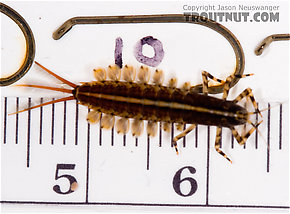 View 3 Pictures
View 3 Pictures
 View 3 Pictures
View 3 PicturesCollected April 1, 2007 from Mystery Creek #62 in New York
Added to Troutnut.com by Troutnut on April 3, 2007
Added to Troutnut.com by Troutnut on April 3, 2007
Penelomax septentrionalis Mayfly Nymph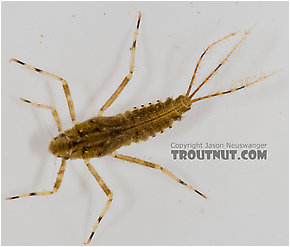 View 3 Pictures
View 3 Pictures
 View 3 Pictures
View 3 PicturesCollected May 13, 2007 from the Delaware River in New York
Added to Troutnut.com by Troutnut on May 18, 2007
Added to Troutnut.com by Troutnut on May 18, 2007
Female Baetis (Blue-Winged Olives) Mayfly Dun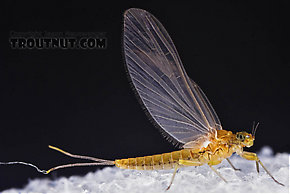 View 4 PicturesI'm guessing this specimen is in the genus Acerpenna because of the very sharp costal process (
View 4 PicturesI'm guessing this specimen is in the genus Acerpenna because of the very sharp costal process (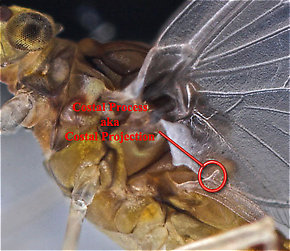 Costal process: A bump or point sticking up from the front margin of an insect's wing, usually the rear wing of certain mayflies. It is sometimes called a costal projection.) on her hind wing. I'm guessing pygmaea because it is the most common species.
Costal process: A bump or point sticking up from the front margin of an insect's wing, usually the rear wing of certain mayflies. It is sometimes called a costal projection.) on her hind wing. I'm guessing pygmaea because it is the most common species.
Editor note: Not Acerpenna. This is most likely Baetis. See comments on this male specimen for rationale. Also compare with the female specimen associated with it.
 View 4 PicturesI'm guessing this specimen is in the genus Acerpenna because of the very sharp costal process (
View 4 PicturesI'm guessing this specimen is in the genus Acerpenna because of the very sharp costal process (
The costal process of a Baetidae dun.
Editor note: Not Acerpenna. This is most likely Baetis. See comments on this male specimen for rationale. Also compare with the female specimen associated with it.
Collected July 1, 2005 from the Bois Brule River in Wisconsin
Added to Troutnut.com by Troutnut on April 22, 2006
Added to Troutnut.com by Troutnut on April 22, 2006
Cinygmula (Dark Red Quills) Mayfly Nymph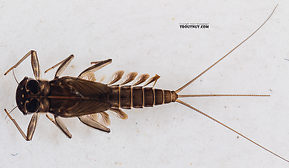 View 7 Pictures
View 7 Pictures
 View 7 Pictures
View 7 PicturesCollected July 28, 2019 from Mystery Creek #199 in Washington
Added to Troutnut.com by Troutnut on July 30, 2019
Added to Troutnut.com by Troutnut on July 30, 2019
Ephemerella aurivillii Mayfly Nymph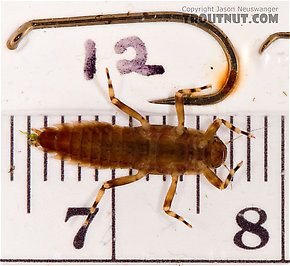 View 9 PicturesI'm pretty sure this is Ephemerella aurivillii. The body is 11mm long, which rules out most other species, and the hind legs seem to be more than 1.5 times longer than the fore legs -- a key characteristic for this species.
View 9 PicturesI'm pretty sure this is Ephemerella aurivillii. The body is 11mm long, which rules out most other species, and the hind legs seem to be more than 1.5 times longer than the fore legs -- a key characteristic for this species.
This specimen isn't in the best of shape, as it's missing all three tails, but it's the only one of its species I captured in this sample.
 View 9 PicturesI'm pretty sure this is Ephemerella aurivillii. The body is 11mm long, which rules out most other species, and the hind legs seem to be more than 1.5 times longer than the fore legs -- a key characteristic for this species.
View 9 PicturesI'm pretty sure this is Ephemerella aurivillii. The body is 11mm long, which rules out most other species, and the hind legs seem to be more than 1.5 times longer than the fore legs -- a key characteristic for this species.This specimen isn't in the best of shape, as it's missing all three tails, but it's the only one of its species I captured in this sample.
Collected May 6, 2007 from Mongaup Creek in New York
Added to Troutnut.com by Troutnut on May 18, 2007
Added to Troutnut.com by Troutnut on May 18, 2007
Male Maccaffertium terminatum Mayfly Spinner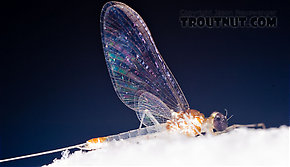 View 11 PicturesI positively identified this specimen under a microscope with a good key. It was one of the more common species in a generally light mixed bag of mayflies over a big Catskill tailwater last night.
View 11 PicturesI positively identified this specimen under a microscope with a good key. It was one of the more common species in a generally light mixed bag of mayflies over a big Catskill tailwater last night.
I swooped this one out of the air while it was mating with a female, so I can be certain about her ID as well.
 View 11 PicturesI positively identified this specimen under a microscope with a good key. It was one of the more common species in a generally light mixed bag of mayflies over a big Catskill tailwater last night.
View 11 PicturesI positively identified this specimen under a microscope with a good key. It was one of the more common species in a generally light mixed bag of mayflies over a big Catskill tailwater last night.I swooped this one out of the air while it was mating with a female, so I can be certain about her ID as well.
Collected June 7, 2007 from the West Branch of the Delaware River in New York
Added to Troutnut.com by Troutnut on June 8, 2007
Added to Troutnut.com by Troutnut on June 8, 2007
Male Ephemerella excrucians (Pale Morning Dun) Mayfly Spinner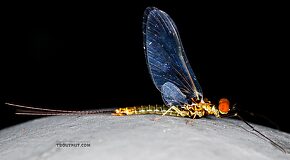 View 4 Pictures
View 4 Pictures
 View 4 Pictures
View 4 PicturesCollected August 1, 2020 from the Henry's Fork of the Snake River in Idaho
Added to Troutnut.com by Troutnut on August 18, 2020
Added to Troutnut.com by Troutnut on August 18, 2020
Heptagenia pulla (Golden Dun) Mayfly Nymph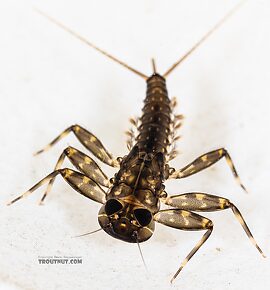 View 11 PicturesThis specimen is interesting because Heptagenia pulla has not been reported from Washington or neighboring states (Saskatchewan is the closest), yet the distinctive key characteristics are clear.
View 11 PicturesThis specimen is interesting because Heptagenia pulla has not been reported from Washington or neighboring states (Saskatchewan is the closest), yet the distinctive key characteristics are clear.
It keys to the genus Heptagenia because the tarsal claw (Tarsal claw: The claws at the tip of the tarsus, on an insect's "foot.") has a single basal (Basal: close to the base; root or beginning) tooth, and the gills on segment 7 have fibrils.
For the species key:
1. The left mandible (Mandible: The paired jaws of an insect which are used for grabbing food, located immediately behind the labrum.) is planate (fairly straight-edged) whereas the right mandible (Mandible: The paired jaws of an insect which are used for grabbing food, located immediately behind the labrum.) is angulate (has one sharp turn on the edge).
2. The labrum (Labrum: The platelike structure forming the roof of the mouth of insects; the upper lip.) is much wider than long.
3. There's a thin light-colored streak lateral (Lateral: To the side.) to the eye on the head.
 View 11 PicturesThis specimen is interesting because Heptagenia pulla has not been reported from Washington or neighboring states (Saskatchewan is the closest), yet the distinctive key characteristics are clear.
View 11 PicturesThis specimen is interesting because Heptagenia pulla has not been reported from Washington or neighboring states (Saskatchewan is the closest), yet the distinctive key characteristics are clear.It keys to the genus Heptagenia because the tarsal claw (Tarsal claw: The claws at the tip of the tarsus, on an insect's "foot.") has a single basal (Basal: close to the base; root or beginning) tooth, and the gills on segment 7 have fibrils.
For the species key:
1. The left mandible (Mandible: The paired jaws of an insect which are used for grabbing food, located immediately behind the labrum.) is planate (fairly straight-edged) whereas the right mandible (Mandible: The paired jaws of an insect which are used for grabbing food, located immediately behind the labrum.) is angulate (has one sharp turn on the edge).
2. The labrum (Labrum: The platelike structure forming the roof of the mouth of insects; the upper lip.) is much wider than long.
3. There's a thin light-colored streak lateral (Lateral: To the side.) to the eye on the head.
Collected April 9, 2021 from the Yakima River in Washington
Added to Troutnut.com by Troutnut on April 12, 2021
Added to Troutnut.com by Troutnut on April 12, 2021
Maccaffertium (March Browns and Cahills) Mayfly Nymph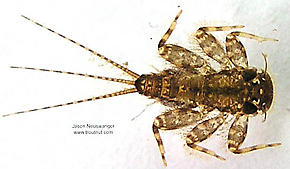 View 4 Pictures
View 4 Pictures
 View 4 Pictures
View 4 PicturesCollected January 12, 2004 from unknown in Wisconsin
Added to Troutnut.com by Troutnut on January 25, 2006
Added to Troutnut.com by Troutnut on January 25, 2006
Female Ephemerella invaria (Sulphur Dun) Mayfly Dun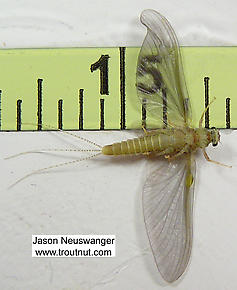 View 2 Pictures
View 2 Pictures
 View 2 Pictures
View 2 PicturesCollected May 23, 2004 from unknown in Wisconsin
Added to Troutnut.com by Troutnut on January 25, 2006
Added to Troutnut.com by Troutnut on January 25, 2006
Top 10 Fly Hatches
Top Gift Shop Designs
Eat mayflies.
Top Insect Specimens
Miscellaneous Sites
Troutnut.com is copyright © 2004-2024 Jason
Neuswanger (email Jason). See my FAQ for information about use of my images.
 privacy policy
privacy policy
